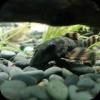I've been out of the game for a few years (since my brother dropped his end of the tank going downstairs while moving), but recently got a 4' x 2' x 2' to create a planted community zen tank. My goal in the past was to make my tank as close to a self sufficient micro-environment as possible (after months of tweaking).
I've spent the last week or so reading half the internet to brush up on aquatic intel and plan the journey towards a heavily planted sustainable community tank. I've noticed detailed info on LEDs is hard to find as they are relatively new, so I'll document my experiences in this thread (though any advice is appreciated).
Here's a basic rundown of my tank as it is today -
Size - 120cm x 60cm x 60cm (approx 380 - 400 L water)
Filter - Aquatopia Internal 600 (600-1000 L/hr flow rate)
Heating - 300w Jager + 100w Heto (set to 24 degrees, thermometer reads 26 degrees)
Lighting - Red, Blue and White LEDs (more on this later)
Substrate - gravel recovered from 2 foot tank (insufficient quantity)
Plants - None
Decoration - 3 x medium sized pieces of driftwood
Inhabitants - 4 x small bristlenose catfish, 4 x small Pakistani (Yoyo) Loaches, 1 x small Upside Down Catfish (Synodontis nigriventris), 8 x small Neon Tetra, 10 x fully grown Serpae Tetra
Test Results (API Master Test Kit)
PH - 7.4 (I'd like to reduce this a bit)
Ammonia - 0.25 ppm (added some Blue Planet Shield post-test)
Nitrite - 0 ppm
Nitrate - 0 ppm
Future Inhabitants
+3 Upside Down Catfish (some friends for the reclusive one man wolf pack)
+16 Neon tetra
6 x Khuli Loaches (to agitate the sand substrate I'll be adding)
Future Aquascaping
+2 Medium/Large pieces of Mallee Root
40kg White Richgro Play Sand (after washing thoroughly)
Dinosaur Dung (as needed)
A variety of plants based on what's healthy and available next time I go to Vebas or Aquotix (the plants for sale at City Farmers Belmont last week were brown/yellow and not fit for sale).
Detail on Lighting
This is still experimental, and I'm doing homework on the science relating to plant growth. At the moment I've rigged up the following parts purchased at Jaycar on a regulated DC 12 volt 500 mA plug -
10 x LED 10mm Red Waterclear 2000mcd
3 x LED 5mm Blue Diffused 350mcd
3 x LED 5mm White Waterclear 4000mcd
The LEDs are wired in series behind 120 ohm resistors (220 ohm for the blues) in a way that allows either 5 or 10 reds on, blue and / or white on, blue + 5 red, or white + 5 red. I've been running the white/blue during the day, and the red at night (and darkness while at work). There has been no algal outbreak in the week since I set it up, though it's fairly dim (I'm considering doubling or tripling the white and blue). The fish seem happy so far. I'm intending to hookup a timer to more consistently regulate the hours of light (7 blue/white, 7 red, 10 dark), and looking into the options for dimming/brightening the LEDs at changeover to ease the transition.
Here are some baseline photos of the tank in different lighting modes (humble beginnings, but something to compare to once it's well planted).



















